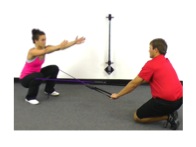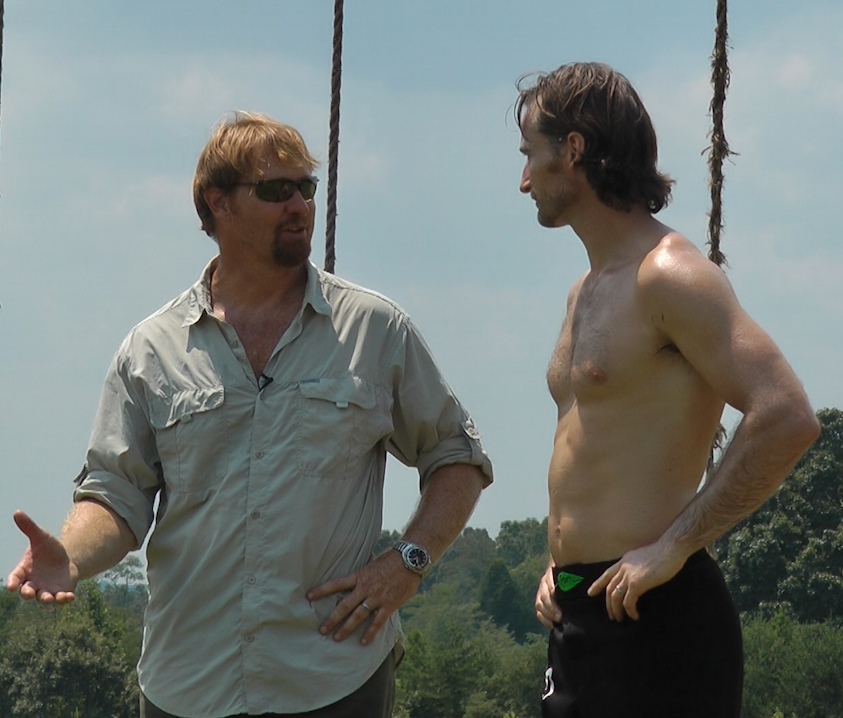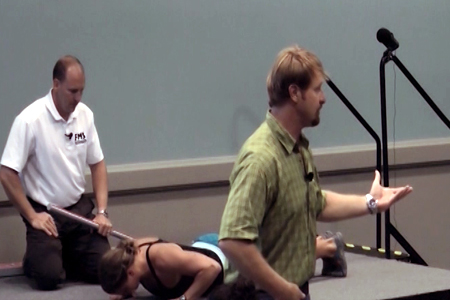As physical therapists, chiropractors, trainers, strength coaches and physical educators, we find ourselves discussing exercises and drills, but what’s the difference? Are they the same? Do they produce the same thing? Do they have different rules? Do they produce different outcomes?
An exercise is simply the rehearsal of a movement or a movement pattern to hopefully produce some degree of improved physical capacity or movement refinement. It is also supposed to produce some form of carryover into another activity.
A drill, from the surface, may appear to be the exact same thing, but in reality a drill is more often described as a small segment of a larger scale activity. Drills should actually encompass the equipment, environment or scenario of a particular skill we’re trying to acquire. Where exercise develops the body before it enters the arena, the drill creates a lifelike scenario of an actual event.

This drill, called medicine ball mini-tennis, is not just a tennis drill. The drill uses elastic bands to create a lateral pull while participants play med ball catch-and-throw with two hands. I give a complete description of the drill in the book Athletic Body in Balance.
I find myself wanting to do more drill work and less exercise as I educate, exercise and rehabilitate my clients and patients. I still love my functional exercises; I still do the chops and lifts; I still do single-leg deadlifts. I still do most everything you have ever heard me speak about or write about, but if I can envision two or three of those exercises being embodied and executed in a drill, I can usually enhance participation and compliance by pointing the user in the direction of something that looks more realistic and lifelike. I would never do this in a situation where serious movement correction or supplementary exercises are needed. However, by creating a situation that forces appropriate mechanics, the drill can often create an opportunity for greater volume, intensity and frequency of a pattern that needs to be repeated.
I learned this early working with tennis players at a time when most were migrating toward an open stance in which the chest and pelvis faced their opponents straight on instead of the old style of tennis where the player would step across the body to execute a shot. They would step in front of the body with the left foot for a right forehand shot or step in front of the body and perform a lunge with the right foot forward to hit a backhand. This closed stance put a much greater coil on the hips and created powerful shots coming up from the legs. Modern tennis produces stronger and stronger athletes who do not necessarily need to cross the body to generate power, but when younger players emulate this technique without the sound fundamental core stability, we found we had to do core training exercises with these young tennis players. The aha moment is, ‘Why not go back to closed-stance play?’
I have even done this with ranked professional players who have an excellent game. I have instructed them to go back to closed stance and double-hand tennis play. Now to a robust male athlete, this is basically like taking a Tour de France rider and asking him to use training wheels. However, something is produced. The individual does the equivalent of multiple chops, lifts and lunges executed in the environment of competition while at the same time working on their sport skill.
John Wooden, the famous UCLA basketball coach, created skill stations and made his players rotate between the skill stations so that while they were performing skills they were also tapping in to a certain degree of physical capacity. The skill station actually provided a conditioning drill—and the conditioning drill created fatigue. The only skill that is really going to get executed in sport, in many cases, is going to be under a certain amount of stress or physical fatigue. Wooden’s skill stations produced a lifelike situation. John Wooden was not able to lean on the programming of a strength coach or the vast exercise equipment athletes have today. He needed to create drills that supplemented the lack of time or equipment he could do with exercise, and this did not hurt him at all.
Often we try to do many exercises when really we could fast-track to a drill. The problem is, when is the right time to progress? I have always used the movement screen as my baseline. When mechanics are available, drills can stimulate appropriate usage and fast-track functional movement patterns. It can create a motivating factor that sometimes is a little bit boring when dispensed with a sheet full of exercises.
I also had an opportunity to work with my daughter’s high school volleyball team. The winter traveling league was looking to improve leg strength and jumping ability. Sitting in the stands with my family last season, we noticed the girls on our team did not really engage their upper bodies when they jumped. They did not cock and throw their arms to help facilitate the reactions that would help improve jump height. Instead of coaching them to use their arms more, I simply gave them a drill that was first shown to me through some videotapes by Vern Gambetta. In his plyometric continuum, Vern suggested that we should not do large amplitude plyometrics if a child could not jump the length of the body. What a wise and simple drill to demonstrate to athletes what they need to incorporate!
One of the first things my wife and I did was to line up each of the girls to see if she could jump the length of her body. A third of the girls easily jumped beyond a tape marking across the floor the top of the head length. Some girls barely made it to the line and some girls fell short of jumping the length of their own bodies. Immediately I had categorized the group of girls into those who were competent, those who were right on the edge and those who needed some work. Those who needed work still got plyometric activity, but it was in the form of jump rope and squatting movement-pattern correction. In a single session, they were picking up six to eight inches of improvement on their standing long jumps. Since these girls had deficient long jumps, they had the greatest amount to improve. The girls who could jump longer than their own body height immediately proceeded to a box jump that was sound for them and safe for plyometric power jumps.
The whole point was that we did not coach jumping. We created a natural drill that imposed the authentic need to engage the upper body. With enough time spent engaging the upper body, the natural reaction will occur. We created a circuit using push presses (for more information on push presses, look at our new DVD, Dynami), jump rope (look up rope jumping in Athletic Body in Balance), squat corrections (part of the Functional Movement System’s criteria) and plyometrics (you can find this information nearly anywhere for basic jumping).
At the end of the session as I talked to the coach, we discussed the circuit setup. Jumping was by far the biggest issue for this team, but they also had another issue. They were not really consistent on their service, so as they rotated between the conditioning stations, they did a service drill. They could not move beyond the service drill until they dropped five serves at the appropriate mark or area they were hitting. This demonstrated how physical fatigue and execution of the skill must be practiced together and should not be separated if improved athleticism is the goal.
Whether I am rehabilitating an athlete to return to sport or activity or training someone to enhance their performance, I always scan the movement patterns and create exercises that would correct or enhance those movement patterns. But when I see a common thread that could allow me to delete three or four exercises and impose one drill, I do it every chance I get. I love being a coach and I love seeing people get engaged with an activity. Disengagement during exercise is one of the biggest problems in physical fitness and training today. Total engagement is how the mind and body learn to work together. This total engagement is sometimes stimulated better by a lifelike drill than an exercise. The problem is we have to know when to use the drill. If the athletes have movement deficiency and a lot of movement dysfunction, this must be corrected first. Clean the canvas, and then paint a new picture.
In effect, movement screening actually gives me a template for whether I am going to do to a drill or stick with a corrective exercise, but the goal is to get to a drill as quickly as possible because this produces an accelerated learning environment. If you want to know understand more deeply, look at the books, The Talent Code and Talent is Overrated. These activities that create a high degree of engagement seem to be the most conducive to improve motor learning and advance a physical skill.





